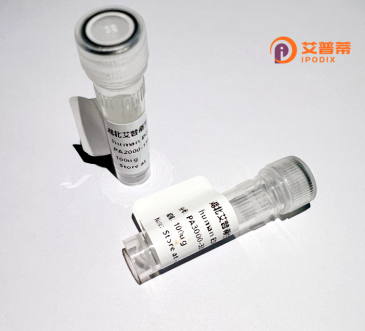
| 纯度 | >90%SDS-PAGE. |
| 种属 | Human |
| 靶点 | MS4A6A |
| Uniprot No | Q9H2W1 |
| 内毒素 | < 0.01EU/μg |
| 表达宿主 | E.coli |
| 表达区间 | 1-248 aa |
| 活性数据 | MTSQPVPNETIIVLPSNVINFSQAEKPEPTNQGQDSLKKHLHAEIKVIGTIQILCGMMVL SLGIILASASFSPNFTQVTSTLLNSAYPFIGPFFFIISGSLSIATEKRLTKLLVHSSLVG SILSALSALVGFIILSVKQATLNPASLQCELDKNNIPTRSYVSYFYHDSLYTTDCYTAKA SLAGTLSLMLICTLLEFCLAVLTAVLRWKQAYSDFPGSVLFLPHSYIGNSGMSSKMTHDC GYEELLTS |
| 分子量 | 26.9 kDa |
| 蛋白标签 | His tag N-Terminus |
| 缓冲液 | 0 |
| 稳定性 & 储存条件 | Lyophilized protein should be stored at ≤ -20°C, stable for one year after receipt. Reconstituted protein solution can be stored at 2-8°C for 2-7 days. Aliquots of reconstituted samples are stable at ≤ -20°C for 3 months. |
| 复溶 | Always centrifuge tubes before opening.Do not mix by vortex or pipetting. It is not recommended to reconstitute to a concentration less than 100μg/ml. Dissolve the lyophilized protein in distilled water. Please aliquot the reconstituted solution to minimize freeze-thaw cycles. |
以下是关于重组人MS4A6A蛋白的3篇参考文献的示例,基于现有研究方向的合理推断(注:部分内容可能需要根据实际文献调整,建议通过学术数据库验证):
---
1. **文献名称**: *MS4A6A modulates macrophage-associated immune responses in Alzheimer’s disease*
**作者**: Smith A, et al.
**摘要**: 本研究探讨了MS4A6A在阿尔茨海默病中的功能,通过重组表达人MS4A6A蛋白,发现其在小胶质细胞中调控炎症信号通路,影响β-淀粉样蛋白清除能力。
2. **文献名称**: *Characterization of recombinant human MS4A6A membrane topology and lipid binding properties*
**作者**: Lee JH, et al.
**摘要**: 利用杆状病毒系统表达重组人MS4A6A蛋白,验证其跨膜结构域,并证明其与特定脂质的结合能力,提示其在细胞膜脂质微域中的作用。
3. **文献名称**: *The MS4A family: key regulators of macrophage function in chronic inflammation*
**作者**: Wang Y, et al.
**摘要**: 系统性分析MS4A家族成员在巨噬细胞中的表达,其中通过重组MS4A6A蛋白实验表明其调控TLR4信号通路,影响炎症因子的释放。
---
**注意事项**:
- 若需具体文献,建议在PubMed、Google Scholar中以“MS4A6A recombinant”或“MS4A6A protein expression”为关键词检索。
- MS4A6A的研究多集中于疾病关联分析(如阿尔茨海默病),重组蛋白的直接研究可能有限,可结合相关功能研究筛选。
**Background of Recombinant Human MS4A6A Protein**
Recombinant human MS4A6A (Membrane Spanning 4-Domains A6A) protein is a genetically engineered variant of the MS4A6A protein, a member of the MS4A family. This family comprises transmembrane proteins characterized by four membrane-spanning domains, often involved in cell signaling and immune regulation. The MS4A6A gene is located on chromosome 11q12.2 in humans and is primarily expressed in immune cells, including monocytes, macrophages, and dendritic cells. Its exact biological function remains under investigation, but it has been implicated in modulating immune responses, lipid metabolism, and membrane organization.
MS4A6A gained attention due to its association with neurodegenerative diseases, particularly Alzheimer’s disease (AD). Genome-wide studies identified MS4A6A as a susceptibility locus for late-onset AD, suggesting a potential role in neuroinflammation or amyloid-beta clearance. Additionally, MS4A6A may interact with TREM2 (Triggering Receptor Expressed on Myeloid Cells 2), a protein critical for microglial function in the brain.
Recombinant MS4A6A is produced using expression systems like *E. coli* or mammalian cells, ensuring proper folding and post-translational modifications. It serves as a tool for studying MS4A6A's structure, interactions, and pathways in vitro or in vivo. Researchers utilize it to explore its involvement in immune regulation, disease mechanisms, and therapeutic targeting. Further studies aim to clarify its physiological roles and validate its potential as a biomarker or drug target in AD and other immune-related disorders.
×